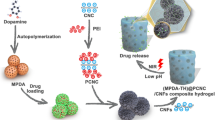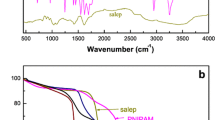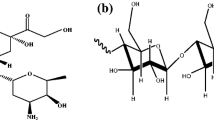Abstract
Several hydrogels-based delivery systems are designed and studied in order to meet the requirements in biomedical fields. Herein, the possibility of carbon dots (CDs)-incorporated hydrogel nanocomposites was investigated for the drug release study. Highly fluorescent CDs synthesized from groundnuts using hydrothermal method were characterized with TEM, FTIR, UV–visible and fluorescence spectroscopy. pH-responsive biodegradable hydrogel nanocomposites were synthesized using agarose polymer and agarose–poly(vinyl alcohol) copolymer with the successful integration of CDs. CDs improved the swelling as well as the biodegradation properties of the prepared hydrogel nanocomposites. Structural changes of prepared hydrogel nanocomposites have been characterized using FTIR, SEM and TGA analysis. Hydrogel nanocomposites showed highly porous surface as shown by SEM analysis. In this study, norfloxacin (NFX) was used as a model drug to investigate the in vitro release behavior at two different pH (pH 1.2 and pH 7.4). NFX release from hydrogel nanocomposites followed zero-order kinetics, and Korsemeyer–Peppas model confirmed the release of NFX through erosion of hydrogel nanocomposites. Degradation of hydrogel nanocomposites films was checked using hen egg lysozyme enzyme which confirmed the biodegradable nature of prepared hydrogel nanocomposites films. MTT assay confirmed the nontoxic nature of hydrogel nanocomposites films when treated with blood cells (PBMC).
Graphic abstract













Similar content being viewed by others
References
Swaroop K, Somashekarappa HM (2016) Swelling and mechanical properties of radiation cross linked Au/PVA hydrogel nanocomposites. Radiat Eff Defect S 171:869–878
Hana C, Caia N, Chanb V, Liua M, Fenga X, Yu F (2018) Enhanced drug delivery, mechanical properties and antimicrobial activities in poly (lactic acid) nanofiber with mesoporous Fe3O4-COOH nanoparticles. Colloids Surf A 559:104–114
Yan QW, Ya NX, Shuang RL, Xue HZ, Heng XF, Xiao GW, Sheng BS, Xiao NL, Min W, Wei YC (2017) Nanocomposite carbon dots/PAM fluorescent hydrogels and their mechanical properties. J Polym Res 24:224
Roshni V, Sweta M, Manas KS, Ottoor D (2019) One pot green synthesis of C-dots from groundnuts and its application as Cr(VI) sensor and in vitro bioimaging agent. J Photochem Photobiol A Chem 3:7328–7336
Han D, Feiyue D, Pengchang L, Liu P, Chen Z, Shen J (2015) DNA − Carbon dots function as fluorescent vehicles for drug delivery. ACS Appl Mater Interfaces 7:6889–6897
Niladri S, Gyanaranjan S, Rashmita D, Das R, Prusty G, Sarat KS (2017) Carbon quantum dot tailored calcium alginate hydrogel for pH responsive controlled delivery of vancomycin. Eur J Pharm Sci 109:359–371
Valmikinathan C, Mukhatyar VA, Jain L, Karumbaiah MD, Bellamkonda R (2012) Photo cross linkable chitosan based hydrogels for neural tissue engineering. Soft Matter 8:1964–1976
Sotoudeh SG, Pourfallah A, Barati R, Davarnejad R, Farahani M, Memar A (2010) Dynamical modeling and experimental analysis on the swelling behavior of SIPN hydrogels. Ind Eng Chem Res 49:10111–10115
Subhraseema D, Usharani S (2013) Cyclodextrin mediated controlled release of naproxen from pH sensitive chitosan/poly(vinyl alcohol) hydrogels for colon targeted delivery. Ind Eng Chem Res 52:14192–14200
Pourjavadi A, Reza G (2006) pH-Sensitivity and swelling kinetics of partially hydrolyzed chitosan-g-poly (acrylamide) hydrogels. Turk J Chem 30:595–608
Vijay M, Akshay P, Sourav T, Kesharwani P (2018) Carbon dots: emerging theranostic nanoarchitectures. Drug Discov Today 23:1219–1232
Hamidi MA, Azadi Rafiei P (2008) Hydrogel nanoparticles in drug delivery. Adv Drug Deliv Rev 60:1638–1649
Date P, Ottoor D (2016) pH dependent controlled release of CTAB incorporated dipyridamole drug from agar-based hydrogel. Polym Plast Technol Eng 55:403–413
Neelam G, Mayuri B, Gitanjali M (2015) Carbon dots rooted agarose hydrogel hybrid platform for optical detection and separation of heavy metal ions. ACS Appl Mater Interfaces 7:3058–3067
Ankur A, Suhela T, Kalpana R, Verma V (2017) Agarose bioplastic-based drug delivery system for surgical and wound dressings. Eng Life Sci 17:204–214
Girin TK, Thakur A, Alexander A, Ajazuddin Badwaik H, Tripathi DK (2012) Modified chitosan hydrogels as drug delivery and tissue engineering systems: present status and applications. Acta Pharm Sin B 2:439–449
Liu J, Li L (2005) SDS-aided immobilization and controlled release of camptothecin from agarose hydrogel. Eur J Pharm Sci 25:237–244
Liu J, Li L (2007) Diffusion of camptothecin immobilized with cationic surfactant into agarose hydrogel containing anionic carrageenan. J Biomed Mater Res A 83:1103–1109
Jianbo L, Xiaohai Y, Kemin W, Wang Q, Ji H, Wu C, Li J, He X, Tang J, Huang J (2012) Combining physical embedding and covalent bonding for stable encapsulation of quantum dots into agarose hydrogels. J Mater Chem 22:495
Li J, Zhang L, Gu J, Sunb Y, Ji X (2015) Cross-linking of poly (vinyl alcohol) with N,N′- methylene bisacrylamide via a radical reaction to prepare pervaporation membranes. RSC Adv 5:19859
Kumar A, Soo S (2017) PVA-based hydrogels for tissue engineering: a review. Int J Polym Mater 66:159–182
Gong M, Zhang L, Zuo Y, Zou Q, Wang Y, Wang L, Li Y (2012) Investigation on the interpenetrating polymer networks (ipns) of poly(vinyl alcohol) and poly(n-vinyl pyrrolidone) hydrogel and it’s in vitro bioassessment. J Appl Polym Sci 125:2799–2806
Vasile C, Zaikov G (2009) Environmentally degradable materials based on multicomponent polymeric systems. CRC Press, Boca Raton
Rizwan M, Yahya R, Hassan A, Yar M, Azzahari AD, Selvanathan V, Sonsudin F, Abouloula CN (2017) pH Sensitive hydrogels in drug delivery: brief history, properties, swelling, and release mechanism material selection and applications. Polymers 9:137
Thahera PD, Ashok Latha K, Shailaja T, Nyamathulla S, Uhumwangho MU (2012) Formulation and evaluation of Norfloxacin gastro retentive drug delivery systems using natural polymers. Int J Curr Pharm Res 1:155–164
Breda SA, Jimenez- Kairuz AF, Manzo RH, Olivera ME (2009) Solubility behavior and biopharmaceutical classification of novel high-solubility ciprofloxacin and norfloxacin pharmaceutical derivatives. Int J Pharma 371:106–113
Dua K, Ramana MV, Singh Sara UV, Himaja M, Agrawal A, Garg V, Pabreja K (2007) Investigation of enhancement of solubility of norfloxacin β-cyclodextrin in presence of acidic solubilizing additives. Curr Drug Deliv 4:1
Achyut K, Neelam G, Gitanjali M, Chowdhury D (2015) Green chitosan–carbon dots nanocomposite hydrogel film with superior properties. Carbohydr Polym 115:238–245
Siamak J, Hassan N (2018) Doxorubicin loaded carboxymethyl cellulose/graphene quantum dot nanocomposite hydrogel films as a potential anticancer drug delivery system. Mater Sci Eng C87:50–59
Barkhordari S, Yadollahi M, Namazi H (2014) pH sensitive nanocomposite hydrogel beads based on carboxymethyl cellulose/layered double hydroxide as drug delivery systems. J Polym Res 21:454
Sachdeva A, Ishita M, Gopinath P (2016) Carbon dots incorporated polymeric hydrogels as multifunctional platform for imaging and induction of apoptosis in lung cancer cells. Colloids Surf B Biointerfaces 141:242–252
Arcot RC, Chan YJ, Choong ST, Muniandy T, Muralidharan S, Arumugam SD (2011) In vitro studies and evaluation of metformin marketed tablets-Malaysia. J Appl Pharm Sci 01:214–217
Das D, Pal S (2015) Dextrin/poly (HEMA): pH responsive porous hydrogel for controlled release of ciprofloxacin. Int J Biol Macromol 72:171–178
Dash S, Murthy PN, Nath L, Chowdhury P (2010) Kinetic modeling on drug release from controlled drug delivery systems. Acta Pol Pharm 67:217–223
Das D, Patra P, Ghosh P, Rameshbabu AP, Dhara S, Pal S (2016) Dextrin and poly (lactide)-based biocompatible and biodegradable nanogel for cancer targeted delivery of doxorubicin hydrochloride. Polym Chem 7:2965–2975
Das D, Das R, Ghosh P, Dhara S, Pandac AB, Pal S (2013) Dextrin cross linked with poly (HEMA): a novel hydrogel for colon specific delivery of ornidazole. RSC Adv 3:25340
Shi X, Zheng Y, Wang G (2014) pH- and electro-response characteristics of bacterial cellulose nanofiber/sodium alginate hybrid hydrogels for dual controlled drug delivery. RSC Adv 4:47056
Ferrari M, Fornasiero MC, Isetta AM (1990) MTT colorimetric assay for testing macrophage cytotoxic activity in vitro. J Immunol Methods 131:165–172
Molaee N, Mosayebi G, Pishdadian A, Ejtehadifar M, Ganji A (2017) Evaluating the proliferation of human peripheral blood mononuclear cells using MTT assay. Int J Basic Sci Med 2:25–28
Pourjavad A, Farhadpour B, Seidi F (2009) Synthesis and investigation of swelling behavior of new agar based superabsorbent hydrogel as a candidate for agrochemical delivery. Polym Res 16:655–665
Suna W, Zhaob J, Chena S, Guob X, Zhang Q, Suna W, Zhaob J, Chena S, Guob X, Zhang Q (2019) Thermally cross-linked polyvinyl alcohol as gate dielectrics for solution processing organic field-effect transistors. Synth Met 250:73–78
Meng H, Xiaoyu G, Yang H (2016) Low chemically cross-linked PAM/c-dot hydrogel with robustness and superstretchability in both as-prepared and swelling equilibrium states. Macromole 49:3174–3183
Kumaraswamy S, Mallaiah SH (2016) Swelling and mechanical properties of radiation crosslinked Au/PVA hydrogel nanocomposites. Radiat Eff Defects S 171:869–878
Das D, Ghosh P, Dhara S, Panda AB, Pal S (2015) Dextrin and poly (acrylic acid)-based biodegradable, non-cytotoxic, chemically cross-linked hydrogel for sustained release of ornidazole and ciprofloxacin. ACS Appl Mater Interfaces 7:4791–4803
Bulbula YE, Eskitoros-Togaya SM, Korkmazb FD, Dilsiz N (2019) Multi-walled carbon nanotube-incorporating electrospun composite fibrous mats for controlled drug release profile. Int J Pharma 568:118513
Justin R, Chen B (2014) Characterization and drug release performance of biodegradable chitosan-graphene oxide nanocomposites. Carbohydr Polym 103:70–80
Mosmann T (1983) Rapid colorimetric assay for cellular growth and survival: application to proliferation and cytotoxicity assays. J Immunol Methods 65:55–63
Barun MB, Das D, Rameshbabu AP, Santanu DS, Sagar PS (2016) A biodegradable, biocompatible transdermal device derived from carboxymethyl cellulose and multi-walled carbon nanotubes for sustained release of diclofenac sodium. RSC Adv 6:19605–19611
Author information
Authors and Affiliations
Corresponding author
Additional information
Publisher's Note
Springer Nature remains neutral with regard to jurisdictional claims in published maps and institutional affiliations.
Electronic supplementary material
Below is the link to the electronic supplementary material.
Rights and permissions
About this article
Cite this article
Date, P., Tanwar, A., Ladage, P. et al. Carbon dots-incorporated pH-responsive agarose-PVA hydrogel nanocomposites for the controlled release of norfloxacin drug. Polym. Bull. 77, 5323–5344 (2020). https://doi.org/10.1007/s00289-019-03015-3
Received:
Revised:
Accepted:
Published:
Issue Date:
DOI: https://doi.org/10.1007/s00289-019-03015-3




